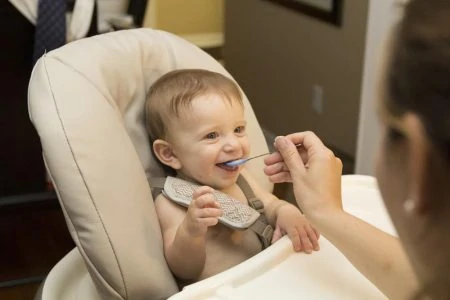Are you tired of fighting to get your child in their high chair at mealtimes?
Many parents wonder at what age their child should stop sitting in their high chair. But, when to make the switch often depends on the child’s development and what you’re comfortable with.
Here are five signs it may be time to ditch the high chair and our tips for making the transition as smooth as possible.
Key Takeaways
- The decision on when to stop using a high chair for a child can depend on the child’s development and parents’ preferences.
- Signs that a child may be ready to transition from a high chair include: the high chair is creating chaos, the child can follow rules, they have become an escape artist, they want to be like older children and adults, and they are starting to try different seats in the house.
- Tips for transitioning out of a high chair include: making the transition gradual, considering a booster seat, making a child-sized seat, and involving the child in the process.
When to Switch From High Chair to Booster Seat?
You may be thinking that it’s time for your child to stop sitting in their high chair, but you don’t want to create extra stress or endangerment by abandoning it too soon.
So how do you know when your child is ready for the next step?
Here are five signs to look out for:
1. The High Chair Is Creating Chaos
If your child gets hysterical whenever you try to sit them in the high chair, it may be time to start transitioning from it.
Mealtime should be about socialization and quality family time, not a war zone. Also, as toddlers become more independent, their high chair might be too restrictive for them.
2. They Can Follow Rules
Following basic high chair safety rules is a must when transitioning, especially if you’re bypassing a booster and going straight to a regular chair.
Before making the switch, be sure your child knows chairs are not for standing on, rocking, lying on, or playing. Make it clear they should remain seated during meals, and all plates, bowls, and utensils are to stay at the table.
As long as your child can sit still long enough to eat and follow these basic safety rules, it really shouldn’t matter what chair they sit in.
3. You’ve Got a Little Houdini
Has your child suddenly become an escape artist capable of unbuckling that five-point harness? Can they climb in and out of the high chair or crib?
Once your child can unbuckle and escape, the high chair becomes more of a safety hazard than helpful. Get your little Houdini out as soon as possible.
4. They Want To Be Like You
Have you noticed your child imitating every little thing you do?
When a child reaches this phase of development, they notice their parents or older siblings aren’t sitting in a high chair. Or, if in a daycare setting, they’ll see all the older kids sitting at a table.
Most children then want to sit in a “big kid” chair.
5. You’ve Got a Little Climber
If your child is starting to try out all the different seats in the house, it might be time to let them sit like a big kid. Once they can safely get in and out of the chairs at your table, go ahead and let them try it out during meals.
Transitioning Out of the High Chair
So you’ve identified the signs above, and your child is ready to graduate from the high chair. But how do you make the transition?
This will vary from child to child and also depend on your preferences.
Here are some of our favorite tips for transitioning from the high chair.
1. Make It Gradual
If your child shows all the signs of being ready to stop sitting in high chairs but isn’t trying to escape yet, you can take your time transitioning to another chair.
Start by having your child sit in a booster chair or regular chair for snacks, but keep using the high chair for meals until you know they are fully capable of sitting still through an entire meal.
You could also keep the high chair available for really messy meals.
2. Consider A Booster
Strapped boosters are a great next step if your child will sit in one. When choosing a booster seat, pick one that has straps for the child and straps to the chair. Avoid restaurant-style boosters, as they can easily topple over.
There are also space saver high chairs, which sit atop a chair and can become strapped boosters by merely removing the tray and pulling them up to the table. Try adding some stickers with your child’s favorite characters to make the booster more enticing.
3. Make it Child-Sized
If your child won’t sit in a booster, but you’re not comfortable with them sitting at the tall kitchen chairs, then a child-sized table and chairs set may be a great alternative.
They can sit in a chair without the worry of falling a few feet to the ground. You could also invite their friends over and let them have a little “dinner party” at their table.
4. Make It a Family Fun Event
Turn off the TV, and sit at the table as a family. Make mealtime a social family event, rather than just scarfing down food. Talk about your day, involve your child, and spend some quality time together.
This also distracts them from getting in and out of their new un-restrictive chair, and they can eat better.
FAQs
Bye Bye, High Chair
It may be time for your child to stop sitting in their high chair if it’s creating chaos or your child is trying out the different seats in the house. Also, when your child can follow the rules, is a little Houdini, or wants to be “just like you,” it’s time to say bye to the high chair!
When you make the switch, consider using a booster or child-size table, and make mealtime a family event.









